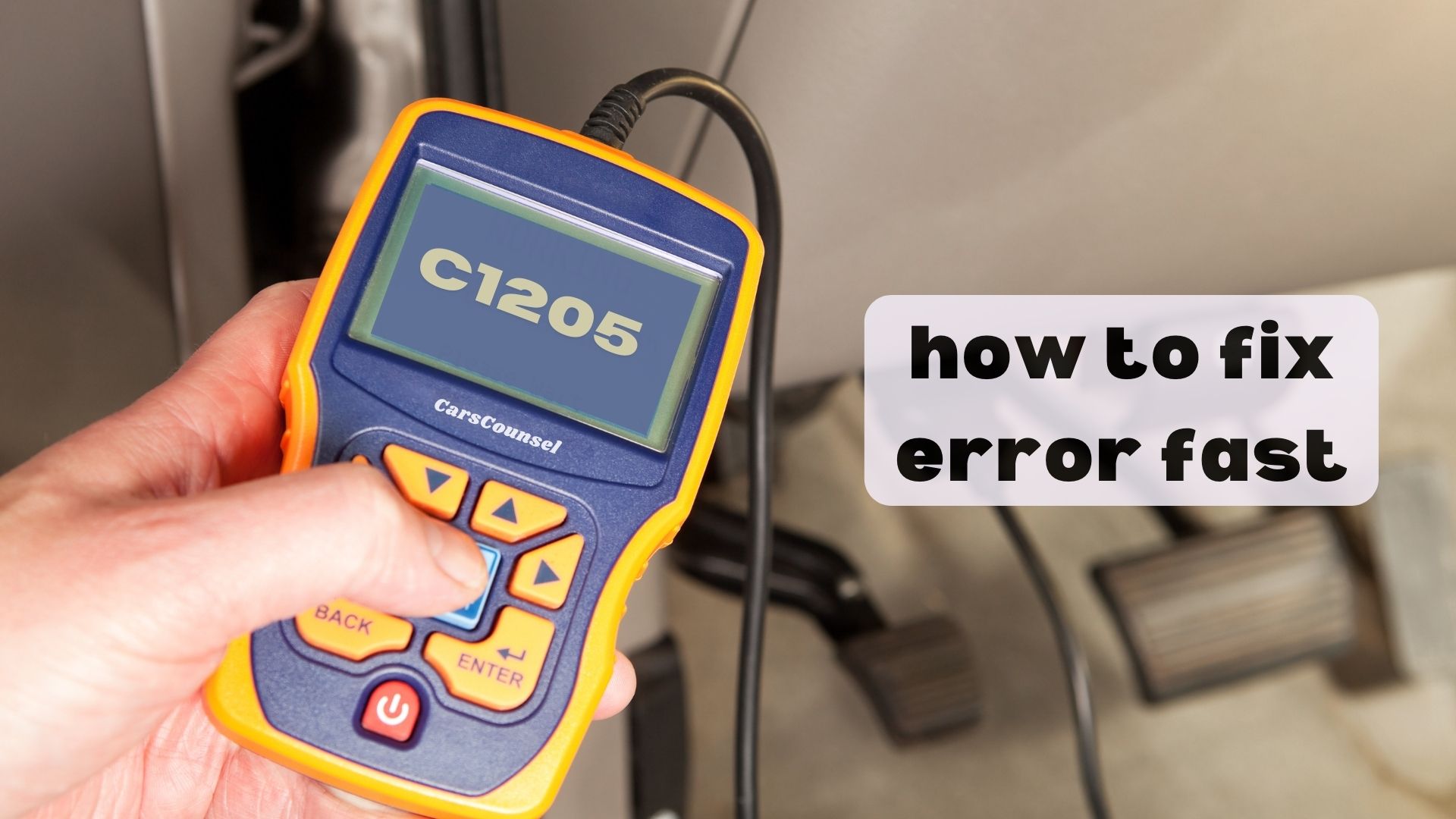It looks like your vehicle’s ABS system has raised a red flag, and you’re faced with the mysterious C1205 code. Don’t worry, we’re about to break it down for you. This code typically indicates a short to ground in the ABS Rear Dump Valve circuit, which can lead to brake failure and compromise your safety on the road. But before you start imagining the worst, let’s take a closer look at the possible causes, symptoms, and tech notes to get to the root of the issue and find a solution.

Quick Navigation
Key Takeaways
- The C1205 code indicates a short to ground in the ABS Rear Dump Valve circuit, a serious issue that can lead to Brake Failure and compromise vehicle safety.
- The faulty ABS Rear Dump Valve or electrical issues such as short circuits or poor connections are likely causes of the C1205 code.
- Symptoms include the Anti-Lock Brake System (ABS) Warning Light and Engine Light (or Service Engine Soon Warning Light) on the dashboard.
- Immediate attention is required to prevent further damage, as the code can lead to potential loss of ABS functionality and braking performance issues.
- Repair or replace damaged components, such as the ABS Rear Dump Valve or wiring, to address the issue and ensure vehicle safety.
Code Meaning
The C1205 code indicates a short to ground in the ABS Rear Dump Valve circuit.
This fault code is a serious issue, as it can lead to Brake Failure and compromise your vehicle’s safety. Brake Failure and compromised vehicle safety are imminent consequences of ignoring this critical issue.
To diagnose this code, you’ll need Diagnostic Tools like a scan tool or code reader to retrieve the specific fault code.
The code’s meaning is straightforward: there’s a short to ground in the ABS Rear Dump Valve circuit, which requires immediate attention to prevent further damage.
With the right tools and knowledge, you can identify the root cause and take corrective action to get your vehicle back on the road safely.
Possible Causes
Now that you’ve identified the C1205 code, it’s time to pinpoint the source of the problem.
The faulty ABS Rear Dump Valve is a likely culprit, which can be caused by electrical issues such as a short circuit or poor connection.
Check the valve’s harness for opens or shorts, and inspect the circuit for damaged wiring.
A faulty ABS module can also trigger this code.
Look for signs of physical damage, corrosion, or bent pins on the related connectors.
Description and Symptoms
Your car’s Anti-Lock Brake System (ABS) Module constantly monitors the ABS Rear Dump Valve to guarantee proper functionality.
If the valve doesn’t meet factory specs, the ABS Module sets the C1205 code. You’ll notice the Anti-Lock Brake System (ABS) Warning Light and Engine Light (or Service Engine Soon Warning Light) on your dashboard.
This code can lead to potential loss of ABS functionality, affecting your vehicle’s brake performance and overall safety. It’s vital to address this issue promptly to safeguard your vehicle’s safety and prevent accidents.
How to Fix
Since the C1205 code indicates a problem with the ABS Rear Dump Valve circuit, you’ll need to identify and address the underlying cause to fix the issue. Start by checking the possible causes, such as a faulty ABS Rear Dump Valve or damaged wiring. Visually inspect the related wiring harness and connectors, looking for broken, bent, or corroded pins. Use a diagnostic scanner to retrieve the specific fault code and perform a wiring diagram analysis to identify the short circuit.
| Step | Action | Tool Needed |
|---|---|---|
| 1 | Check possible causes | Diagnostic scanner |
| 2 | Inspect wiring harness and connectors | Visual inspection |
| 3 | Perform wiring diagram analysis | Wiring diagram software |
| 4 | Inspect brake pads | Brake pad inspection tool |
| 5 | Repair or replace damaged components | Replacement parts |
Code Information
The C1205 code is a specific OBDII trouble code that indicates a problem with the ABS Rear Dump Valve circuit, specifically a short to ground.
You’ll need to perform circuit troubleshooting to identify the root cause of the issue. This may involve an electrical inspection of the related wiring harness and connectors to check for damaged components or broken pins.
The code’s repair importance level is high, and the difficulty level is hard, so it’s essential to address the problem promptly to avoid potential loss of ABS functionality and braking performance issues.
Repair Levels
Repairing the C1205 code requires a thorough understanding of the task’s complexity and importance.
You’ll need to assess the repair’s difficulty level, which is rated as a 3 (Hard), and its importance level, also a 3 (High). This will help you decide on the best repair options.
You can choose to DIY or take your vehicle to a shop. Get shop estimates to compare prices and find the best deal.
Consider factors like labor costs, parts needed, and the extent of the damage when evaluating repair options.
Technical Diagnosis
Diagnosing the C1205 code requires a systematic approach to identify the root cause of the ABS Rear Dump Valve Circuit Short To Ground. You’ll need to use a scan tool to retrieve the specific fault code and follow a diagnostic strategy to pinpoint the issue.
| Diagnostic Step | Action |
|---|---|
| 1. Visual Inspection | Check wiring harness and connectors for damage or corrosion |
| 2. Scan Tool Tips | Use a scan tool to monitor the ABS Rear Dump Valve circuit for shorts or opens |
| 3. Diagnostic Strategies | Perform a voltage drop test to identify any electrical connection issues |
| 4. Advanced Diagnostics | Use a wiring diagram to trace the circuit and identify the root cause of the short |
Cost Estimates
Estimating the cost of repairing the C1205 code involves considering several factors, including the extent of the damage, the parts needed for replacement, and the labor costs charged by the repair shop.
You’ll want to get a clear understanding of the repair costs to plan your budget.
- Diagnostic fees: $75-$150
- Repairing or replacing damaged wiring: $100-$300
- Replacing the faulty dump valve: $200-$500
- Labor costs: $100-$300 per hour, depending on the shop’s rates
More OBD-II Codes
| P0332 | P1382 | P1456 | C1204 |
| C1203 | P1457 | P1491 | P1773 |
| P1783 | P1788 | P1002 | P1003 |
| P1013 | P1014 | P1015 | P1016 |
| P1018 | P1498 | P1656 | P1658 |
| P1666 | P1768 | P1668 | P1738 |
Frequently Asked Questions
Can I Drive My Car With the C1205 Code?
You shouldn’t drive your car with the C1205 code as it may compromise road safety; potential loss of ABS functionality and issues with braking performance can increase the risk of accidents, so it’s best to address the issue promptly to guarantee safe driving and confirm that you’re taking all necessary precautions.
Will the C1205 Code Cause My Car to Fail Inspection?
You’re wondering if the C1205 code will cause your car to fail inspection. Yes, it’s likely, as the code can trigger an Emissions failure, and the Anti-Lock Brake System (ABS) Warning Light being ON may also impact your inspection outcome.
Can a Faulty ABS Module Cause Other Issues?
You’re wondering if a faulty ABS module can cause other issues. Yes, it can lead to ABS sensor failure, triggering multiple trouble codes, and affect overall vehicle safety. Module replacement costs vary, but it’s essential to address the issue to prevent further problems.
Will a Code Reader Reset the C1205 Code?
Coincidentally, you’re wondering if a code reader can reset the C1205 code. You’ll be relieved to know that, yes, a code reader can clear the code, but it won’t fix the underlying issue, and you’ll still need to address the faulty sensor calibration for proper code functionality.
Can a Mechanic Clear the C1205 Code Without Repair?
You can ask a mechanic to clear the code, but it’s only temporary; they’ll use a scan tool for code erasure, which won’t fix the underlying issue, and the code will likely come back until the root cause is properly repaired.
Conclusion
You’ve got a C1205 code – now what? The truth is, ignoring it can lead to brake failure, and that’s a risk you can’t afford to take. By digging into the code’s meaning, possible causes, and symptoms, you’ve taken the first step towards fixing the issue. Remember, immediate attention is key to preventing further damage. So, roll up your sleeves, get to work, and don’t rest until your brakes are back to normal. Your safety depends on it.

